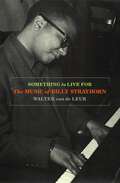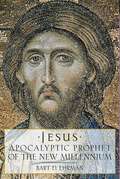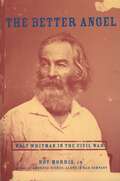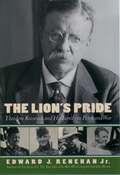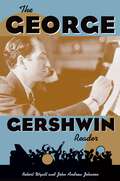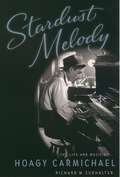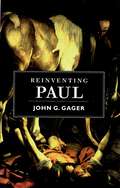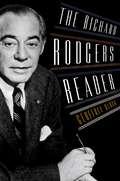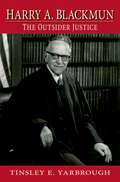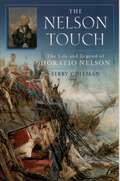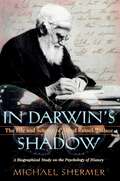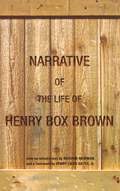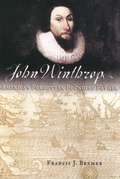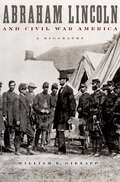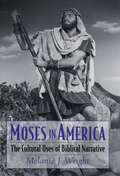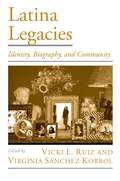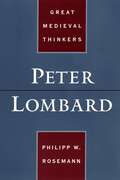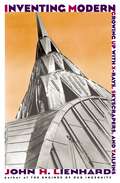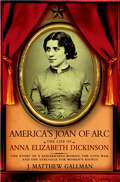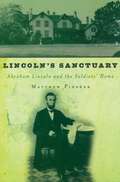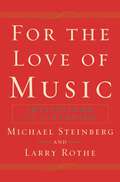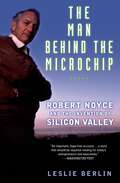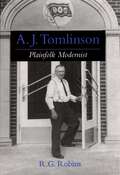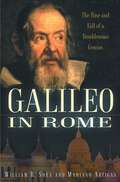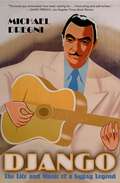- Table View
- List View
Something to Live For: The Music of Billy Strayhorn
by Walter van de LeurDuke Ellington was one of jazz's greatest figures, a composer and bandleader of unparalleled importance and influence. But little attention has been given to his chief musical collaborator, Billy Strayhorn, who created hundreds of compositions and arrangements for his musical partner, and without whom the sound of Ellington's orchestra would have been very different. Now, in Walter van de Leur's provocative new book, Something To Live For, Billy Strayhorn steps out from Ellington's shadow and into the spotlight. Van de Leur argues that far from being merely a follower of Ellington or his alter ego, Strayhorn brought a radically new and visionary way of writing to the Ellington orchestra. Making extensive use, for the first time, of over 3,000 autograph scores, Van de Leur separates Strayhorn from Ellington, establishes who wrote what, and clearly distinguishes between their distinctive musical styles. "Both Strayhorn's and Ellington's oeuvres," writes Van de Leur, "though historically intertwined, nevertheless form coherent, separate musical entities, especially in terms of harmonic, melodic, and structural design." Indeed, Something to Live For allows us to see the characteristic features of Strayhorn's compositions and arrangements, his "musical fingerprints," and to analyze and evaluate his music on its own terms. The book also makes clear that Strayhorn's contribution to the band was much larger, and more original, than has been previously acknowledged. Based on a decade of research and offering detailed analyses of over 70 musical examples, Something to Live For casts new light--and will surely arouse intense debate--on two of the most important composers in the history of jazz.
Jesus: Apocalyptic Prophet of the New Millennium
by Bart D. EhrmanIn this highly accessible discussion, Bart Ehrman examines the most recent textual and archaeological sources for the life of Jesus, along with the history of first-century Palestine, drawing a fascinating portrait of the man and his teachings. Ehrman shows us what historians have long known about the Gospels and the man who stands behind them. Through a careful evaluation of the New Testament (and other surviving sources, including the more recently discovered Gospels of Thomas and Peter), Ehrman proposes that Jesus can be best understood as an apocalyptic prophet--a man convinced that the world would end dramatically within the lifetime of his apostles and that a new kingdom would be created on earth. According to Ehrman, Jesus' belief in a coming apocalypse and his expectation of an utter reversal in the world's social organization not only underscores the radicalism of his teachings but also sheds light on both the appeal of his message to society's outcasts and the threat he posed to Jerusalem's established leadership.
The Better Angel: Walt Whitman in the Civil War
by Roy MorrisFor nearly three years, Walt Whitman immersed himself in the devastation of the Civil War, tending to thousands of wounded soldiers and recording his experiences with an immediacy and compassion unequaled in wartime literature anywhere in the world. In The Better Angel, acclaimed biographer Roy Morris, Jr. gives us the fullest account of Whitman's profoundly transformative Civil War years and an historically invaluable examination of the Union's treatment of its sick and wounded. Whitman was mired in depression as the war began, subsisting on journalistic hackwork, his "great career" as a poet apparently stalled. But when news came that his brother George had been wounded at Fredericksburg, Whitman rushed south to find him. Deeply affected by his first view of the war's casualties, he began visiting the camp's wounded and found his calling for the duration of the war. Three years later, he emerged as the war's "most unlikely hero," a living symbol of American democratic ideals of sharing and brotherhood. Brilliantly researched and beautifully written, The Better Angel explores a side of Whitman not fully examined before, one that greatly enriches our understanding of his later poetry. Moreover, it gives us a vivid and unforgettable portrait of the "other army"--the legions of sick and wounded soldiers who are usually left in the shadowy background of Civil War history--seen here through the unflinching eyes of America's greatest poet.
The Lion's Pride: Theodore Roosevelt and His Family in Peace and War
by Edward J. RenehanIn The Lion's Pride, Edward J. Renehan, Jr. vividly portrays the grand idealism, heroic bravery, and reckless abandon that Theodore Roosevelt both embodied and bequeathed to his children and the tragic fulfillment of that legacy on the battlefields of World War I. Drawing upon a wealth of previously unavailable materials, including letters and unpublished memoirs, The Lion's Pride takes us inside what is surely the most extraordinary family ever to occupy the White House. Theodore Roosevelt believed deeply that those who had been blessed with wealth, influence, and education were duty bound to lead, even--perhaps especially--if it meant risking their lives to preserve the ideals of democratic civilization. Teddy put his principles, and his life, to the test in the Spanish American war, and raised his children to believe they could do no less. When America finally entered the "European conflict" in 1917, all four of his sons eagerly enlisted and used their influence not to avoid the front lines but to get there as quickly as possible. Their heroism in France and the Middle East matched their father's at San Juan Hill. All performed with selfless--some said heedless--courage: Two of the boys, Archie and Ted, Jr., were seriously wounded, and Quentin, the youngest, was killed in a dogfight with seven German planes. Thus, the war that Teddy had lobbied for so furiously brought home a grief that broke his heart. He was buried a few months after his youngest child. Filled with the voices of the entire Roosevelt family, The Lion's Pride gives us the most intimate and moving portrait ever published of the fierce bond between Teddy Roosevelt and his remarkable children.
The George Gershwin Reader (Readers on American Musicians)
by Robert Wyatt John Andrew JohnsonGeorge Gershwin is one of the giants of American music, unique in that he was both a brilliant writer of popular songs and of more serious music. Here, music lovers are treated to a spectacular celebration of this great American composer. The Reader offers a kaleidoscopic collection of writings by Gershwin, as well as those about Gershwin, written by a who's who of famous commentators. More than eighty pieces of superb variety, color, and depth include the critical debate over Gershwin's concert pieces, especially "Rhapsody in Blue" and "An American in Paris." There is a complete section devoted to the controversies over "Porgy and Bess," including correspondence between Gershwin and DuBose Hayward, the opera's librettist, plus unique interviews with the original Porgy and Bess--Todd Duncan and Anne Brown. Sprinkled throughout the book are excerpts from Gershwin's own letters, which offer unique insight into this fascinating and charming man. Along with a detailed chronology of the composer's life, the editors provide informative introductions to each entry. Here is a book for anyone interested in American music. Scholars, performers, and Gershwin's legions of fans will find it an irresistible feast.
Stardust Melody: The Life and Music of Hoagy Carmichael
by Richard M. SudhalterGeorgia on My Mind, Rockin' Chair, Skylark, Lazybones, and of course the incomparable Star Dust--who else could have composed these classic American songs but Hoagy Carmichael? He remains, for millions, the voice of heartland America, eternal counterpoint to the urban sensibility of Cole Porter and George Gershwin. Now, trumpeter and historian Richard M. Sudhalter has penned the first book-length biography of the man Alec Wilder hailed as "the most talented, inventive, sophisticated and jazz-oriented of all the great songwriters--the greatest of the great craftsmen." Stardust Melody follows Carmichael from his roaring-twenties Indiana youth to bandstands and recording studios across the nation, playing piano and singing alongside jazz greats Jack Teagarden, Benny Goodman, Tommy and Jimmy Dorsey, and close friends Bix Beiderbecke and Louis Armstrong. It illuminates his peak Hollywood years, starring in such films as To Have and Have Not and The Best Years of Our Lives, and on radio, records and TV. With compassionate insight Sudhalter depicts Hoagy's triumphs and tragedies, and his mounting despair as rock-and-roll drowns out and lays waste to the last days of a brilliant career. With an insider's clarity Sudhalter explores the songs themselves, still fresh and appealing while reminding us of our innocent American yesterdays. Drawing on Carmichael's private papers and on interviews with family, friends and colleagues, he reveals that "The Old Music Master" was almost as gifted a wordsmith as a shaper of melodies. In all, Stardust Melody offers a richly textured portrait of one of our greatest musical figures, an inspiring American icon.
Reinventing Paul
by John G. GagerThroughout the Christian era, Paul has stood at the center of controversy, accused of being the father of Christian anti-Semitism. But have we misunderstood the man and his teachings for nearly 2,000 years? In this highly accessible book, John Gager challenges this entrenched view of Paul, arguing persuasively that Paul's words have been taken out of their original context, distorted, and generally misconstrued. Gager takes us in search of the "real" Paul--using Paul's own writings. Through an exhaustive analysis of Paul's letters to the Galatians and the Romans, he provides illuminating answers to the key questions: Did Paul repudiate the Law of Moses? Did he believe that Jews had been rejected by God and replaced as His chosen people by Gentiles? Did he consider circumcision to be necessary for salvation? And did he expect Jews to find salvation through Jesus? To all these questions, John Gager answers no. First, he puts Paul's proselytizing in context. Paul was an apostle to the Gentiles, not the Jews. His most vehement arguments were directed not against Judaism but against competing apostles in the Jesus movement who demanded that Gentiles be circumcised and conform to Jewish law in order to be saved. Moreover, Paul relied on rhetorical devices that were familiar to his intended audience but opaque to later readers of the letters. As a result, his message has been misunderstood by all succeeding generations. Reinventing Paul brilliantly sets forth a controversial interpretation of Paul's teaching. This thought-provoking portrait is essential reading for theologians and lay people, historians and philosophers, Christians and Jews.
The Richard Rodgers Reader (Readers on American Musicians)
by Geoffrey BlockRichard Rodgers was one of America's most prolific and best-loved composers. A world without "My Funny Valentine," "The Lady is a Tramp," "Blue Moon," and "Bewitched," to name just a few of the songs he wrote with Lorenz Hart, is scarcely imaginable, and the musicals he wrote with his second collaborator, Oscar Hammerstein--Oklahoma!, Carousel, South Pacific, The King and I, and The Sound of Music--continue to enchant and entertain audiences. Arranged in four sections, Rodgers and Hart (1929-1943), Rodgers and Hammerstein (1943-1960), Rodgers After Hammerstein (1960-1979), and The Composer Speaks (1939-1971), The Richard Rodgers Reader offers a cornucopia of informative, perceptive, and stylish biographical and critical overviews. It also contains a selection of Rodgers's letters to his wife Dorothy in the 1920s, the 1938 Time magazine cover story and New Yorker profiles in 1938 and 1961, and essays and reviews by such noted critics as Brooks Atkinson, Eric Bentley, Leonard Bernstein, Lehman Engel, Walter Kerr, Ken Mandelbaum, Ethan Mordden, George Jean Nathan, and Alec Wilder. The volume features personal accounts by Richard Adler, Agnes de Mille, Joshua Logan, Mary Martin, and Diahann Carroll. The collection concludes with complete selections from more than thirty years of Rodgers's own writings on topics ranging from the creative process, the state of the Broadway theater, even Rodgers's bout with cancer, and a generous sample from the candid and previously unpublished Columbia University interviews. For anyone wishing to explore more fully the life and work of a composer whose songs and musicals have assumed a permanent--and prominent--place in American popular culture, The Richard Rodgers Reader will offer endless delights.
Harry A. Blackmun: The Outsider Justice
by Tinsley YarbroughWhen appointed to the Supreme Court in 1970 by President Nixon, Harry A. Blackmun was seen as a quiet, safe choice to complement the increasingly conservative Court of his boyhood friend, Warren Burger. No one anticipated his seminal opinion championing abortion rights in Roe v. Wade, the most controversial ruling of his generation, which became the battle cry of both supporters and critics of judicial power and made Blackmun a liberal icon. Harry A. Blackmun: The Outsider Justice is Tinsley E. Yarbrough's penetrating account of one of the most outspoken and complicated figures on the Supreme Court. As a justice, Blackmun stood at the pinnacle of the American judiciary. Yet when he took his seat on the Court, Justice Blackmun felt "almost desperate," overwhelmed with feelings of self-doubt and inadequacy over the immense responsibilities before him. Blackmun had overcome humble roots to achieve a Harvard education, success as a Minneapolis lawyer and resident counsel to the prestigious Mayo Clinic, as well as a distinguished record on the Eighth Circuit federal appeals court. But growing up in a financially unstable home with a frequently unemployed father and an emotionally fragile mother left a permanent mark on the future justice. All his life, Harry Blackmun considered himself one of society's outsiders, someone who did not "belong." Remarkably, though, that very self-image instilled in the justice, throughout his career, a deep empathy for society's most vulnerable outsiders--women faced with unwanted pregnancies, homosexuals subjected to archaic laws, and ultimately, death-row inmates. To those who saw his career as the constitutional odyssey of a conservative jurist gradually transformed into a champion of the underdog, Blackmun had a ready answer: he had not changed; the Court and the issues before them changed. The justice's identification with the marginalized members of society arguably provides the overarching key to that consistency. Thoroughly researched, engagingly written, Harry A. Blackmun: The Outsider Justice offers an in-depth, revelatory portrait of one of the most intriguing jurists ever to sit on the Supreme Court. Relying on in-depth archival material, in addition to numerous interviews with Blackmun's former clerks, Yarbrough here presents the definitive biography of the great justice, ultimately providing an illuminating window into the inner-workings of the modern Supreme Court.
In Darwin's Shadow: The Life and Science of Alfred Russel Wallace: A Biographical Study on the Psychology of History
by Michael ShermerVirtually unknown today, Alfred Russel Wallace was the co-discoverer of natural selection with Charles Darwin and an eminent scientist who stood out among his Victorian peers as a man of formidable mind and equally outsized personality. Now Michael Shermer rescues Wallace from the shadow of Darwin in this landmark biography. Here we see Wallace as perhaps the greatest naturalist of his age--spending years in remote jungles, collecting astounding quantities of specimens, writing thoughtfully and with bemused detachment at his reception in places where no white man had ever gone. Here, too, is his supple and forceful intelligence at work, grappling with such arcane problems as the bright coloration of caterpillars, or shaping his 1858 paper on natural selection that prompted Darwin to publish (with Wallace) the first paper outlining the theory of evolution. Shermer also shows that Wallace's self-trained intellect, while powerful, also embraced surprisingly naive ideas, such as his deep interest in the study of spiritual manifestations and seances. Shermer shows that the same iconoclastic outlook that led him to overturn scientific orthodoxy as he worked in relative isolation also led him to embrace irrational beliefs, and thus tarnish his reputation. As author of Why People Believe Weird Things and founding publisher of Skeptic magazine, Shermer is an authority on why people embrace the irrational. Now he turns his keen judgment and incisive analysis to Wallace's life and his contradictory beliefs, restoring a leading figure in the rise of modern science to his rightful place.
Narrative of the Life of Henry Box Brown
by Henry Box BrownIn 1849, Henry Brown escaped from slavery by shipping himself in a three-foot-by-two-foot wooden crate from Virginia to an anti-slavery office in Philadelphia. Twenty-seven hours and 350 miles later, Brown stepped out of his box to begin a new life. This is his memoir, originally published in 1851 in England, as fresh and compelling today as it was 150 years ago. This extraordinary narrative paints an indelible portrait of life in slavery. With a keen sense of irony, Brown examines the "peculiar institution"--from the hypocrisy of slave-owning Christian preachers, to the system of bribery that forced slaves to purchase the rights to their own belongings, to the practice of separating slave families with no warning. The story also describes one of the most audacious, creative escapes ever completed. A classic slave narrative, it makes for unforgettable reading.
John Winthrop: America's Forgotten Founding Father
by Francis J. BremerJohn Winthrop's effort to create a Puritan "City on a Hill" has had a lasting effect on American values, and many remember this phrase famously quoted by the late Ronald Reagan. However, most know very little about the first American to speak these words. In John Winthrop, Francis J. Bremer draws on over a decade of research in England, Ireland, and the United States to offer a superb biography of the first governor of the Massachusetts Bay Colony, one rooted in a detailed understanding of his first forty years in England. Indeed, Bremer provides an extensive, path-breaking treatment of Winthrop's family background, youthful development, and English career. His dissatisfaction with the decline of the "godly kingdom of the Stour Valley" in which he had been raised led him on his errand to rebuild such a society in a New England. In America, Winthrop would use the skills he had developed in England as he struggled with challenges from Roger Williams and Anne Hutchinson, among others, and defended the colony from English interference. We also see the personal side of Winthrop--the doubts and concerns of the spiritual pilgrim, his everyday labors and pleasures, his feelings for family and friends. And Bremer also sheds much light on important historical moments in England and America, such as the Reformation and the rise of Puritanism, the rise of the middling class, the colonization movement, and colonial relations with Native Americans. Incorporating previously unexplored archival materials from both sides of the Atlantic, here is the definitive portrait of one of the giants of our history. John Winthrop recevied an honorable Mention, The Colonial Dames of America Book Award.
Abraham Lincoln and Civil War America: A Biography
by William E. GienappIn Abraham Lincoln and Civil War America, historian William Gienapp provides a remarkably concise, up-to-date, and vibrant biography of the most revered figure in United States history. While the heart of the book focuses on the Civil War, Gienapp begins with a finely etched portrait of Lincoln's early life, from pioneer farm boy to politician and lawyer in Springfield, to his stunning election as sixteenth president of the United States. Students will see how Lincoln grew during his years in office, how he developed a keen aptitude for military strategy and displayed enormous skill in dealing with his generals, and how his war strategy evolved from a desire to preserve the Union to emancipation and total war. Gienapp shows how Lincoln's early years influenced his skills as commander-in-chief and demonstrates that, throughout the stresses of the war years, Lincoln's basic character shone through: his good will and fundamental decency, his remarkable self-confidence matched with genuine humility, his immunity to the passions and hatreds the war spawned, his extraordinary patience, and his timeless devotion. A former backwoodsman and country lawyer, Abraham Lincoln rose to become one of our greatest presidents. This biography offers a vivid account of Lincoln's dramatic ascension to the pinnacle of American history.
Latina Legacies: Identity, Biography, and Community (Viewpoints on American Culture)
by Vicki L. Ruiz Virginia Sánchez KorrolSpanning two centuries, this collection documents the lives of fifteen remarkable Latinas who witnessed, defined, defied, and wrote about the forces that shaped their lives. As entrepreneurs, community activists, mystics, educators, feminists, labor organizers, artists and entertainers, Latinas used the power of the pen to traverse and transgress cultural conventions.
Peter Lombard (Great Medieval Thinkers)
by Philipp W. RosemannPeter Lombard is best known as the author of a celebrated work entitled Book of Sentences, which for several centuries served as the standard theological textbook in the Christian West. It was the subject of more commentaries than any other work of Christian literature besides the Bible itself. The Book of Sentences is essentially a compilation of older sources, from the Scriptures and Augustine down to several of the Lombard's contemporaries, such as Hugh of Saint Victor and Peter Abelard. Its importance lies in the Lombard's organization of the theological material, his method of presentation, and the way in which he shaped doctrine in several major areas. Despite his importance, however, there is no accessible introduction to Peter Lombard's life and thought available in any modern language. This volume fills this considerable gap. Philipp W. Rosemann begins by demonstrating how the Book of Sentences grew out of a long tradition of Christian reflection-a tradition, ultimately rooted in Scripture, which by the twelfth century had become ready to transform itself into a theological system. Turning to the Sentences, Rosemann then offers a brief exposition of the Lombard's life and work. He proceeds to a book-by-book examination and interpretation of its main topics, including the nature and attributes of God, the Trinity, creation, angelology, human nature and the Fall, original sin, Christology, ethics, and the sacraments. He concludes by exploring how the Sentences helped shape the further development of the Christian tradition, from the twelfth century through the time of Martin Luther.
Inventing Modern: Growing up with X-Rays, Skyscrapers, and Tailfins
by John H. LienhardModern is a word much used, but hard to pin down. In Inventing Modern, John H. Lienhard uses that word to capture the furious rush of newness in the first half of 20th-century America. An unexpected world emerges from under the more familiar Modern. Beyond the airplanes, radios, art deco, skyscrapers, Fritz Lang's Metropolis, Buck Rogers, the culture of the open road--Burma Shave, Kerouac, and White Castles--lie driving forces that set this account of Modern apart. One force, says Lienhard, was a new concept of boyhood--the risk-taking, hands-on savage inventor. Driven by an admiration of recklessness, America developed its technological empire with stunning speed. Bringing the airplane to fruition in so short a time, for example, were people such as Katherine Stinson, Lincoln Beachey, Amelia Earhart, and Charles Lindbergh. The rediscovery of mystery powerfully drove Modern as well. X-Rays, quantum mechanics, and relativity theory had followed electricity and radium. Here we read how, with reality seemingly altered, hope seemed limitless. Lienhard blends these forces with his childhood in the brave new world. The result is perceptive, engaging, and filled with surprise. Whether he talks about Alexander Calder (an engineer whose sculptures were exercises in materials science) or that wacky paean to flight, Flying Down to Rio, unexpected detail emerges from every tile of this large mosaic. Inventing Modern is a personal book that displays, rather than defines, an age that ended before most of us were born. It is an engineer's homage to a time before the bomb and our terrible loss of confidence--a time that might yet rise again out of its own postmodern ashes.
America's Joan of Arc: The Life of Anna Elizabeth Dickinson
by J. Matthew GallmanOne of the most celebrated women of her time, a spellbinding speaker dubbed the Queen of the Lyceum and America's Joan of Arc, Anna Elizabeth Dickinson was a charismatic orator, writer, and actress, who rose to fame during the Civil War and remained in the public eye for the next three decades. J. Matthew Gallman offers the first full-length biography of Dickinson to appear in over half a century. Gallman describes how Dickinson's passionate patriotism and fiery style, coupled with her unabashed abolitionism and biting critiques of antiwar Democrats--known as Copperheads--struck a nerve with her audiences. In barely two years, she rose from an unknown young Philadelphia radical, to a successful New England stump speaker, to a true national celebrity. At the height of her fame, Dickinson counted many of the nation's leading reformers, authors, politicians, and actors among her friends. Among the dozens of famous figures who populate the narrative are Susan B. Anthony, Whitelaw Reid, William Lloyd Garrison, Frederick Douglass, Elizabeth Cady Stanton, and Harriet Beecher Stowe. Gallman shows how Dickinson's life illuminates the possibilities and barriers faced by nineteenth-century women, revealing how their behavior could at once be seen as worthy, highly valued, shocking, and deviant.
Lincoln's Sanctuary: Abraham Lincoln and the Soldiers' Home
by Matthew PinskerAfter the heartbreaking death of his son Willie, Abraham Lincoln and his family fled the gloom that hung over the White House, moving into a small cottage in Washington, D.C., on the grounds of the Soldiers' Home, a residence for disabled military veterans. In Lincoln's Sanctuary, historian Matthew Pinsker offers a fascinating portrait of Lincoln's stay in this cottage and tells the story of the president's remarkable growth as a national leader and a private man. Lincoln lived at the Soldiers' Home for a quarter of his presidency, and for nearly half of the critical year of 1862, but most Americans (including many scholars) have not heard of the place. Indeed, this is the first volume to specifically connect this early "summer White House" to key wartime developments, including the Emancipation Proclamation, the firing of McClellan, the evolution of Lincoln's "Father Abraham" image, the election of 1864, and the assassination conspiracy. Through a series of striking vignettes, the reader discovers a more accessible Lincoln, demonstrating what one visitor to the Soldiers' Home described as his remarkable "elasticity of spirits." At his secluded cottage, the president complained to his closest aides, recited poetry to his friends, reconnected with his wife and family, conducted secret meetings with his political enemies, and narrowly avoided assassination attempts. Perhaps most important, he forged key friendships that helped renew his flagging spirits. The cottage became a refuge from the pressures of the White House, a place of tranquility where Lincoln could refresh his mind. Based on research in rarely tapped sources, especially the letters and memoirs of people who lived or worked at the Soldiers' Home, Lincoln's Sanctuary offers the unexpected--a completely fresh view of Abraham Lincoln--through the window of a place that helped shape his presidency.
For The Love of Music: Invitations to Listening
by Michael Steinberg Larry RotheThe power of music, the way it works on the mind and heart, remains an enticing mystery. Now two noted writers on classical music, Michael Steinberg and Larry Rothe, explore the allure of this melodious art--not in the clinical terms of social scientists--but through stories drawn from their own experience. In For the Love of Music, Steinberg and Rothe draw on a lifetime of listening to, living with, and writing about music, sharing the delights and revelatory encounters they have had with Mozart, Brahms, Stravinsky, and a host of other great (and almost-great) composers. At once highly personal and immediately accessible, their writings shed light on those who make music and those who listen to it--drawing readers into the beautiful and dangerous terrain that has meant so much to the authors. In recounting how they themselves came to love music, Steinberg and Rothe offer keys for listening. You will meet the man who created the sound of Hollywood's Golden Age and you will learn how composers have addressed issues as contemporary as AIDS and the terrorist attacks of September 11.
The Man Behind the Microchip: Robert Noyce and the Invention of Silicon Valley
by Leslie BerlinHailed as the Thomas Edison and Henry Ford of Silicon Valley, Robert Noyce was a brilliant inventor, a leading entrepreneur, and a daring risk taker who piloted his own jets and skied mountains accessible only by helicopter. Now, in The Man Behind the Microchip, Leslie Berlin captures not only this colorful individual but also the vibrant interplay of technology, business, money, politics, and culture that defines Silicon Valley. Here is the life of a high-tech industry giant. The co-founder of Fairchild Semiconductor and Intel, Noyce co-invented the integrated circuit, the electronic heart of every modern computer, automobile, cellular telephone, advanced weapon, and video game. With access to never-before-seen documents, Berlin paints a fascinating portrait of Noyce: an ambitious and intensely competitive multimillionaire who exuded a "just folks" sort of charm, a Midwestern preacher's son who rejected organized religion but would counsel his employees to "go off and do something wonderful," a man who never looked back and sometimes paid a price for it. In addition, this vivid narrative sheds light on Noyce's friends and associates, including some of the best-known managers, venture capitalists, and creative minds in Silicon Valley. Berlin draws upon interviews with dozens of key players in modern American business--including Andy Grove, Steve Jobs, Gordon Moore, and Warren Buffett; their recollections of Noyce give readers a privileged, first-hand look inside the dynamic world of high-tech entrepreneurship. A modern American success story, The Man Behind the Microchip illuminates the triumphs and setbacks of one of the most important inventors and entrepreneurs of our time.
A. J. Tomlinson: Plainfolk Modernist (Religion in America)
by R. G. RobinsA.J. Tomlinson (1865-1943) ranks among the leading figures of the early Pentecostal movement, and like so many of his cohorts, he was as complex as he was colorful. Arriving in Appalachia as a home missionary determined to uplift and evangelize poor mountain whites, he stayed to become the co-founder and chief architect of the Church of God (Cleveland, TN) and the Church of God of Prophecy, which together with their minor offspring now constitute the third-largest denominational family within American Pentecostalism. R.G. Robins's biography recreates the world in which Tomlinson operated, and through his story offers a new understanding of the origins of the Pentecostal movement. Scholars have tended to view Pentecostalism as merely one among many anti-modernist movements of the early twentieth century. Robins argues that this is a misreading of the movement's origins-the result of projecting the modernist/fundamentalist controversy of the 1920s back onto the earlier religious landscape. Seeking to return the story of Pentecostalism to its proper historical context, Robins suggests that Pentecostalism should rightly be seen as an outgrowth of the radical holiness movement of the late nineteenth century. He argues that, far from being anti-modern, Pentecostals tended to embrace modernity. Pentecostal modernism, however, was a working class or "plainfolk" phenomenon, and it is the plainfolk character of the movement that has led so many scholars to mislabel it as anti-modern or fundamentalist. Through the compelling narrative of Tomlinson's life story, Robins sheds new light on late-nineteenth and early-twentieth century American religion, and provides a more refined lens through which to view the religious dynamics of our own day. v
Galileo in Rome: The Rise and Fall of a Troublesome Genius
by William R. Shea Mariano ArtigasGalileo's trial by the Inquisition is one of the most dramatic incidents in the history of science and religion. Today, we tend to see this event in black and white--Galileo all white, the Church all black. Galileo in Rome presents a much more nuanced account of Galileo's relationship with Rome. The book offers a fascinating account of the six trips Galileo made to Rome, from his first visit at age 23, as an unemployed mathematician, to his final fateful journey to face the Inquisition. The authors reveal why the theory that the Earth revolves around the Sun, set forth in Galileo's Dialogue, stirred a hornet's nest of theological issues, and they argue that, despite these issues, the Church might have accepted Copernicus if there had been solid proof. More interesting, they show how Galileo dug his own grave. To get the imprimatur, he brought political pressure to bear on the Roman Censor. He disobeyed a Church order not to teach the heliocentric theory. And he had a character named Simplicio (which in Italian sounds like simpleton) raise the same objections to heliocentrism that the Pope had raised with Galileo. The authors show that throughout the trial, until the final sentence and abjuration, the Church treated Galileo with great deference, and once he was declared guilty commuted his sentence to house arrest. Here then is a unique look at the life of Galileo as well as a strikingly different view of an event that has come to epitomize the Church's supposed antagonism toward science.
Django: The Life and Music of a Gypsy Legend
by Michael DregniDjango Reinhardt was arguably the greatest guitarist who ever lived, an important influence on Les Paul, Charlie Christian, B.B. King, Jerry Garcia, Chet Atkins, and many others. Yet there is no major biography of Reinhardt. Now, in Django, Michael Dregni offers a definitive portrait of this great guitarist. Handsome, charismatic, childlike, and unpredictable, Reinhardt was a character out of a picaresque novel. Born in a gypsy caravan at a crossroads in Belgium, he was almost killed in a freak fire that burned half of his body and left his left hand twisted into a claw. But with this maimed left hand flying over the frets and his right hand plucking at dizzying speed, Django became Europe's most famous jazz musician, commanding exorbitant fees--and spending the money as fast as he made it. Dregni not only chronicles this remarkably colorful life--including a fascinating account of gypsy culture--but he also sheds much light on Django's musicianship. He examines his long musical partnership with violinist Stéphane Grappelli--the one suave and smooth, the other sharper and more dissonant--and he traces the evolution of their novel string jazz ensemble, Quintette du Hot Club de France. Indeed, the author spotlights Django's amazing musical diversity, describing his swing-styled Nouveau Quintette, his big band Django's Music, and his later bebop ensemble, as well as his many compositions, including symphonic pieces influenced by Ravel and Debussy and his unfinished organ mass inspired by Bach. And along the way, the author offers vivid snapshots of the jazz scene in Paris--colorful portraits of Josephine Baker, Bricktop, Louis Armstrong, Coleman Hawkins, and countless others--and of Django's vagabond wanderings around France, Europe, and the United States, where he toured with Duke Ellington. Capturing the extraordinary life and times of one of the great musicians of the twentieth century, Django is a must-read portrait of a true original.
